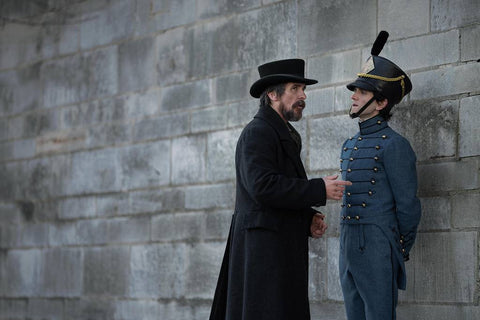
‘The Pale Blue Eye’ Is A Truly Macabre Military Murder Mystery Movie
Most people with even a sliver of English literature education recognize Edgar Allen Poe as perhaps the greatest illustrator of the macabre in literary history.
What you probably don’t know is that before Poe penned such morose metrical compositions as “Annabel Lee” or “The Raven,” he did a brief stint in 1830 as a cadet at the U.S. Military Academy at West Point.
In 1831, however, Poe, averse to the rigidity of military life, would quit attending classes and get himself kicked out of the fabled institution by way of a court-martial.
Not much is known about his social life at the Army’s academy, so author Louis Bayard took it upon himself to fill in those biographical gaps and pen a fictional tale titled “The Pale Blue Eye” — a West Point murder mystery that essentially serves as a Poe origin story.
That story now forms the basis of a movie set to debut in select theaters and on Netflix.
From director Scott Cooper (“Black Mass,” “Hostiles,” “Antlers”) comes “The Pale Blue Eye,” a dark, mystical exploration of Poe’s fascination with the funereal, fueled by a murder mystery he is attempting to solve alongside depressed detective Augustus Landor, played by Christian Bale.
Poe is portrayed by Harry Melling (”Queen’s Gambit,” “Harry Potter”), who breathes a sort of awkward earnestness into the passionately perturbed poet.
Set in the winter at New York’s West Point campus, the movie begins with the death of a cadet initially believed to have been a suicide by hanging. However, when the young soldier’s body is desecrated in the morgue — his heart is removed — it becomes apparent that there are more sinister forces at work.
Called upon to solve the case by none other than Superintendent Sylvanus Thayer, Landor reveals the deceased cadet was not only maimed after death but actually the victim of murder.
After a brief encounter searching the snowy grounds, and a run-in at a local Hudson River pub where Poe suggests the murderer must also be a poet, Landor enlists the young cadet to help suss out who, among the students, might be responsible.
An impenetrable sense of gloom, references to the occult and cinematography that pits the grays of winter against piercing cobalt — a scheme particularly noteworthy on the West Point uniforms — creates a viewer experience best described as chilling.
Many encounters between fictional characters contain allusions to future works that Poe would produce in his real-life writing career, but none are so present as the “Tell-Tale Heart,” the poem in which an anonymous narrator plots to murder and then kills his housemate, an elderly man, after being driven mad by his evil “pale blue eye.”
The murderer of that tale slowly unravels while hearing what he believes to be the sound of the beating heart of the dead man, whose body he has hidden beneath his floorboards. His guilt later forces him to confess.
This reference, among many, plays into the secrets behind this West Point murder mystery. Much like “Tell-Tale Heart,” it ends with both a plot twist and an unexpected expression of guilt — no doubt befitting of a macabre Poe epic.
“The Pale Blue Eye” premieres on Dec. 23 and lands on Netflix Jan. 6.
Originally published by Military Times, our sister publication.
